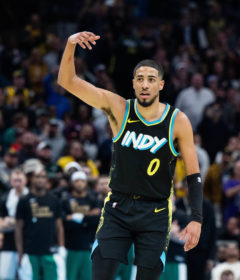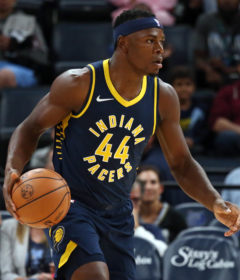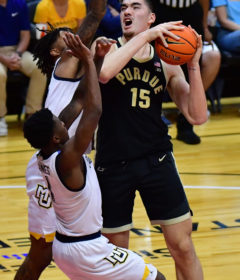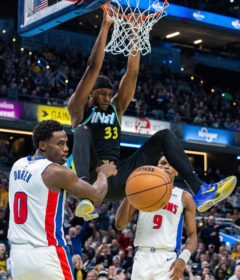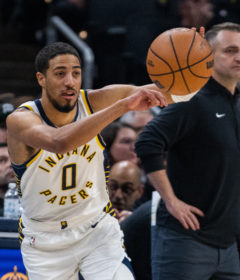Purdue center A.J. Hammons emerging as a star
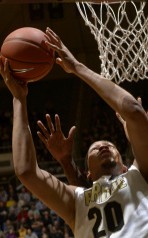
By CLIFF BRUNT
ISL Editor
It’s starting to come together for Purdue center A.J. Hammons, and as a result, things are coming together for the Boilermakers.
The 7-foot, 280-pound freshman center is becoming the beast Purdue coach Matt Painter has envisioned. Hammons is averaging 10.6 points, 6.4 rebounds and 2.0 blocks per game as the Boilermakers (9-8, 3-2 Big Ten) head into Saturday’s home game against West Virginia.
Hammons has been particularly tough during conference play. He leads the Big Ten in blocked shots, is fourth in rebounds and 11th in field-goal percentage.

His main contribution has been on defense. He had nine blocks in his first eight games, but has 25 in his past nine, nearly three per game. He had five blocks against Penn State on Sunday, then six on Wednesday against Nebraska. I know, it was Penn State and Nebraska, but the success will be big for his confidence going forward, and increased confidence is a big part of what needs to happen for Hammons. He needs to believe wholeheartedly that he owns the paint before Indiana comes to town. He’s still not quite as aggressive as he could be, which makes his success so far even more impressive.
But it’s not just the blocks that have already made Hammons one of the more valuable players in the early part of conference play. His presence bothers opposing teams, much the same way Roy Hibbert’s presence bothers teams that drive to the hoop against the Indiana Pacers. Hammons dramatically effects the quality of the shots opposing teams take, and in many cases, teams don’t even bother challenging him.
His play has helped the Boilermakers become one of the best defensive teams in the Big Ten. The Boilermakers rank fifth in scoring defense (63.4 points per game) and third in field-goal percentage defense (38.9 percent), behind Indiana and Wisconsin. Purdue is one of the worst teams in 3-point percentage defense, but inside the 3-point line, opponents have made just 89 of 228 shots (39 percent). With that kind of success on the interior, eventually the perimeter defenders will feel more comfortable knowing that Hammons will handle business if they get beat.
Hammons is also growing as an offensive player. In his past four games, he has made 23 of 41 shots (56 percent) and is averaging 14.8 points and 8.3 rebounds, not bad numbers on a team that plays at a relatively deliberate pace.
A good sign for Hammons is that he played 32 minutes against Nebraska, a season high. For a player of his size, sometimes playing a high number of minutes can be a challenge because it’s hard for a big guy to lug all that weight around. Painter was concerned about Hammons’ conditioning early on. That clearly isn’t the case now.
I’d still like to see a man of Hammons’ size get to the free-throw line more – he didn’t shoot any free throws against Nebraska and he’s only shot more than seven in a game once this season. That might have more to do with his teammates than his lack of aggression, though Hammons is enough of a weapon that his teammates should be required to feed him or sit.
Still, even with limited touches, Hammons has become a steady force on offense, scoring in double figures in six of his past seven games. The man many criticized early for being inconsistent has become one of Purdue’s most consistent pieces.
Hammons’ biggest problem in this nine-game stretch has been foul trouble. He has finished with four fouls three times and three fouls once. Painter said Hammons is still figuring out how to time a block, when to leave his feet and when to just be big.
As tough as folks have been on Hammons, remember, JaJuan Johnson came off the bench the second half of his freshman year and he only scored in double figures four times that season. Hammons is actually ahead of the curve by becoming such a difference maker so early on.
Saturday’s matchup with West Virginia’s Aaric Murray should be a good test for Hammons. Murray is a junior and West Virginia’s No. 2 scorer. He’s 6-foot-10 and 245 pounds, and he averages 10 points and 7.1 rebounds per contest. A matchup with a tall, experienced player who is actually listed as a center will be good for him and should further his development. He needs this kind of test before the rest of the Big Ten schedule.
Hammons has no limits. He has the potential to be a great player. Not just good, great. Step one is that he needs to know he can be great. Step two is that he has to want it, step three is that he has to work at it and step four is that he has to embrace what greatness is within the framework of his gifts. That means no more fadeaways or cheap reach-in fouls. It means being the biggest, baddest man on the court. Judging by his recent success, he’s getting there. That can only be good for Purdue and its fans.

